1997 CHEVROLET BLAZER suspension
[x] Cancel search: suspensionPage 188 of 402
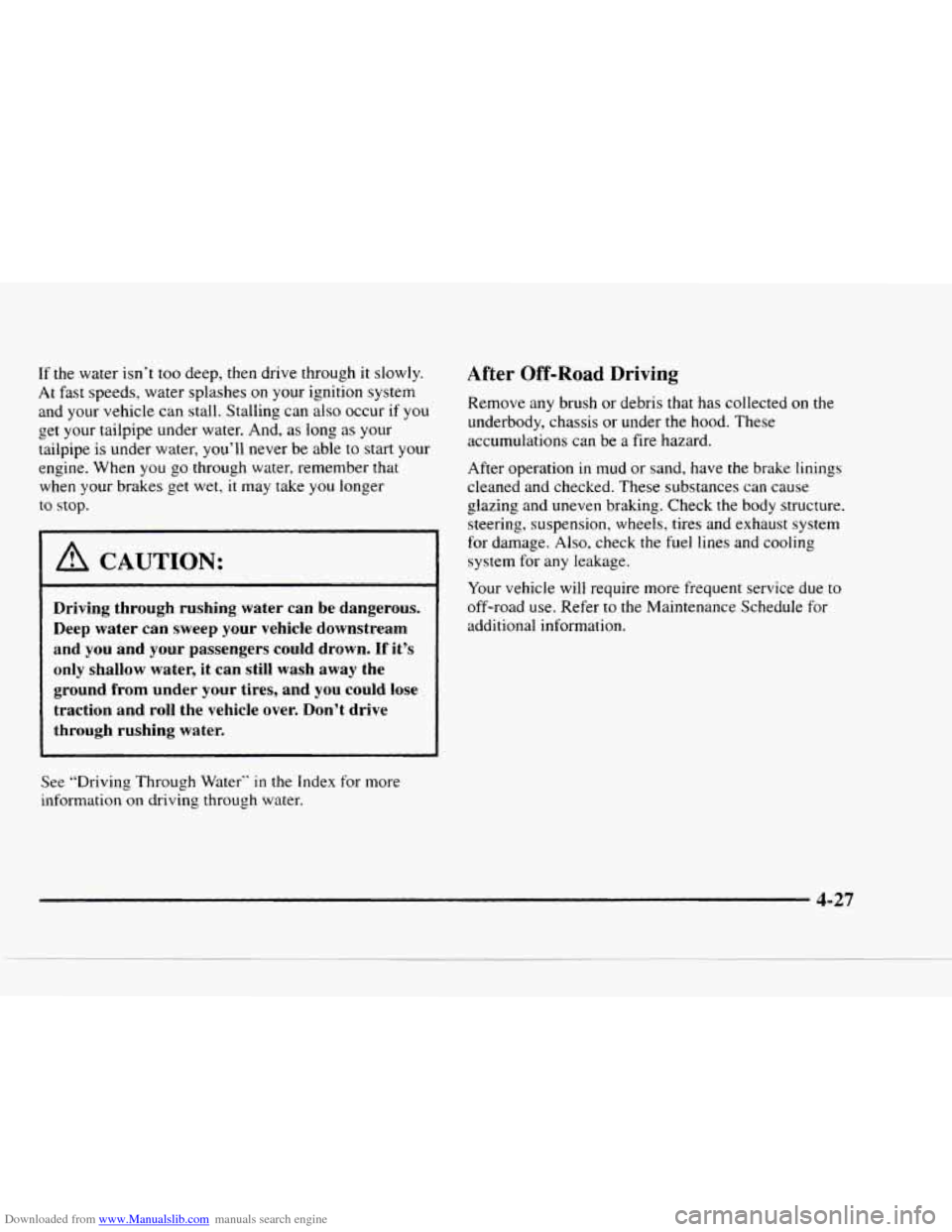
Downloaded from www.Manualslib.com manuals search engine If the water isn’t too deep, then drive through it slowly.
At fast speeds, water splashes
on your ignition system
and your vehicle can stall. Stalling can also occur if you
b get your tailpipe under water. And, as long as your
tailpipe is under water, you’ll never be able
to start your
engine. When
you go through water, remember that
when your brakes get wet, it may take you longer
to stop.
I A CAUTION:
Driving through rushing water can be dangerous.
Deep water can sweep your vehicle downstream
and you and your passengers could drown.
If it’s
only shallow water, it can still wash away the
ground from under your tires, and you could lose
traction and roll the vehicle over. Don’t drive
through rushing water.
See “Driving Through Water” in the Index for more
information on driving throwh water.
After Off-Road Driving
Remove any brush or debris that has collected on the
underbody, chassis or under the hood. These
accumulations can be
a fire hazard.
After operation in mud or sand, have
the brake linings
cleaned and checked. These substances can cause
glazing and uneven braking. Check the body structure.
steering, suspension, wheels, tires and exhaust system
for damage. Also, check the fuel lines and cooling
system for any leakage.
Your vehicle will require more frequent service due
to
off-road use. Refer to the Maintenance Schedule for
additional information.
Page 204 of 402
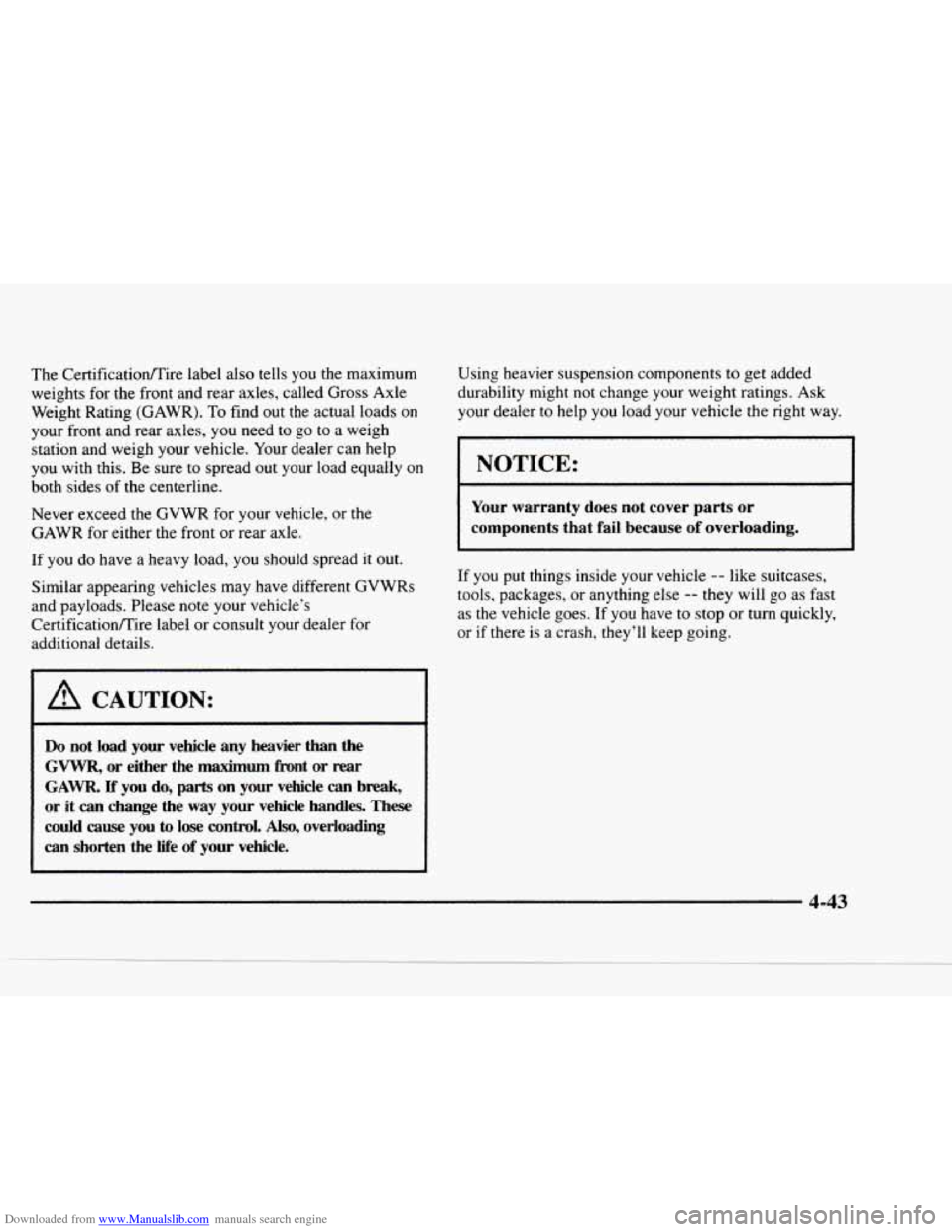
Downloaded from www.Manualslib.com manuals search engine The Certificatioflire label also tells you the maximum
weights for
the front and rear axles, called Gross Axle
Weight Rating (GAWR).
To find out the actual loads on
your front and rear axles, you need to go to a weigh
station and weigh your vehicle. Your dealer can help
you with this. Be sure to spread out your load equally on
both sides
of the centerline.
Never exceed the GVWR for your vehicle, or the
GAWR for either
the front or rear axle.
If you
do have a heavy load, you should spread it out.
Similar appearing vehicles may have different
GVWRs
and payloads. Please note your vehicle’s
Certificationmire label or consult your dealer for
additional details.
I A CAUTION:
~~~____ ~~ ~
Do not load your vehicie any heavier than the
GVWR, or either the maximum front or rear
GAWR. If you do, parts on your vehicle can break,
or it can change the way your vehicle handles. These
could cause you to lose control. Also, overloading
can shorten the life of your vehicle.
Using heavier suspension components to get added
durability might not change your weight ratings. Ask
your dealer to help you load your vehicle the right way.
NOTICE:
Your warranty does not cover parts or
components that
fail because of overloading.
If you put things inside your vehicle -- like suitcases,
tools, packages, or anything else
-- they will go as fast
as
the vehicle goes. If you have to stop or turn quickly,
or if there is a crash, they’ll keep going.
.. .. 4-43
Page 225 of 402
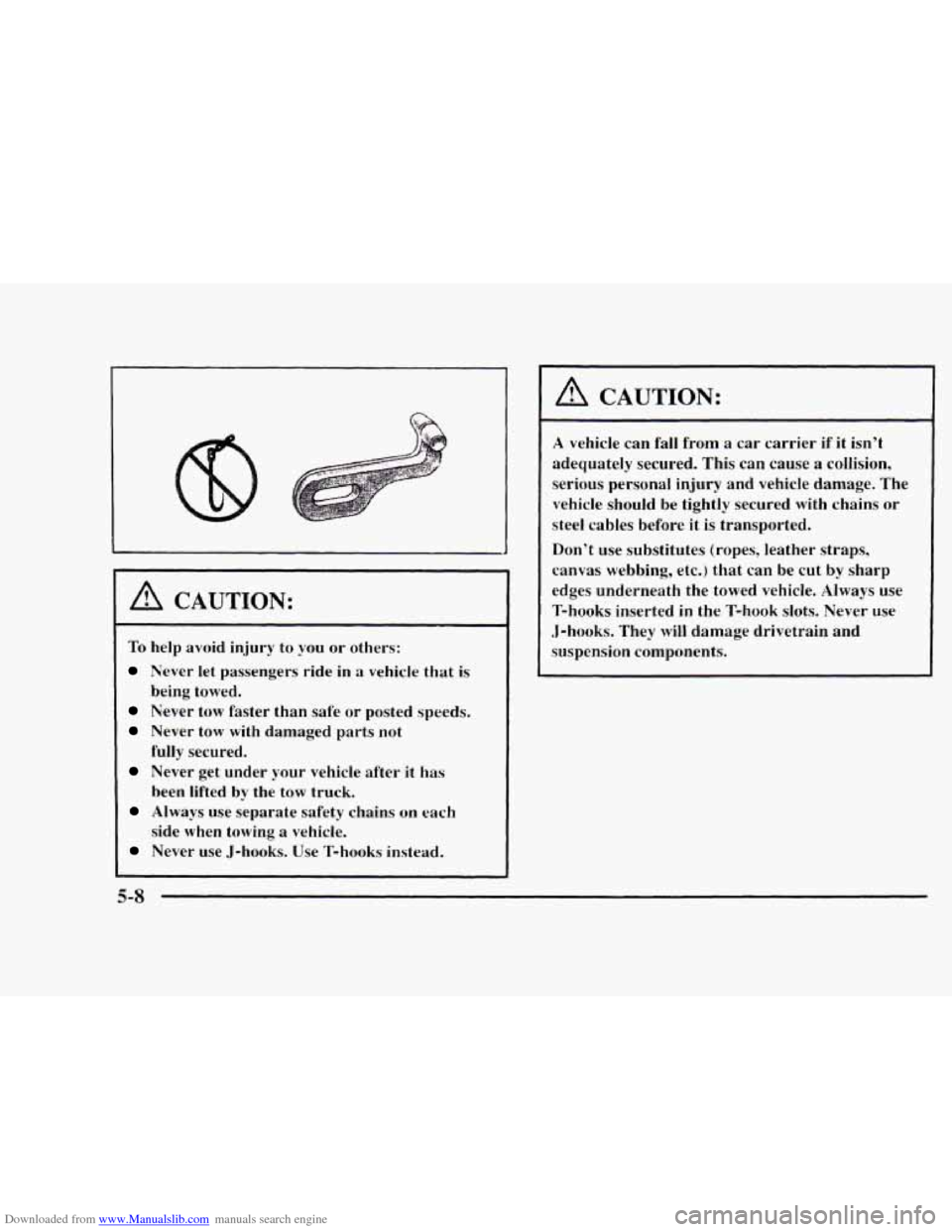
Downloaded from www.Manualslib.com manuals search engine A CAUTION:
To help avoid injury to you or others:
Never let passengers ride in a vehicle that is
Never tow faster than safe or posted speeds.
Never tow with damaged parts not
Never get under your vehicle after it has
Always use separate safety chains on each
Never use J-hooks. Use T-hooks instead.
being
towed.
fully secured.
been lifted by the tow truck.
side when towing a vehicle.
A CAUTION:
A vehicle can fall from a car carrier if it isn’t
adequately secured. This can cause a collision,
serious personal injury and vehicle damage. The
vehicle should be tightly secured with chains or
steel cables before it is transported.
Don’t use substitutes (ropes, leather straps,
canvas webbing, etc.) that can be cut
by sharp
edges underneath the towed vehicle. Always use
T-hooks inserted
in the T-hook slots. Never use
,J-hooks. They will damage drivetrain and
suspension components.
5-8
Page 227 of 402
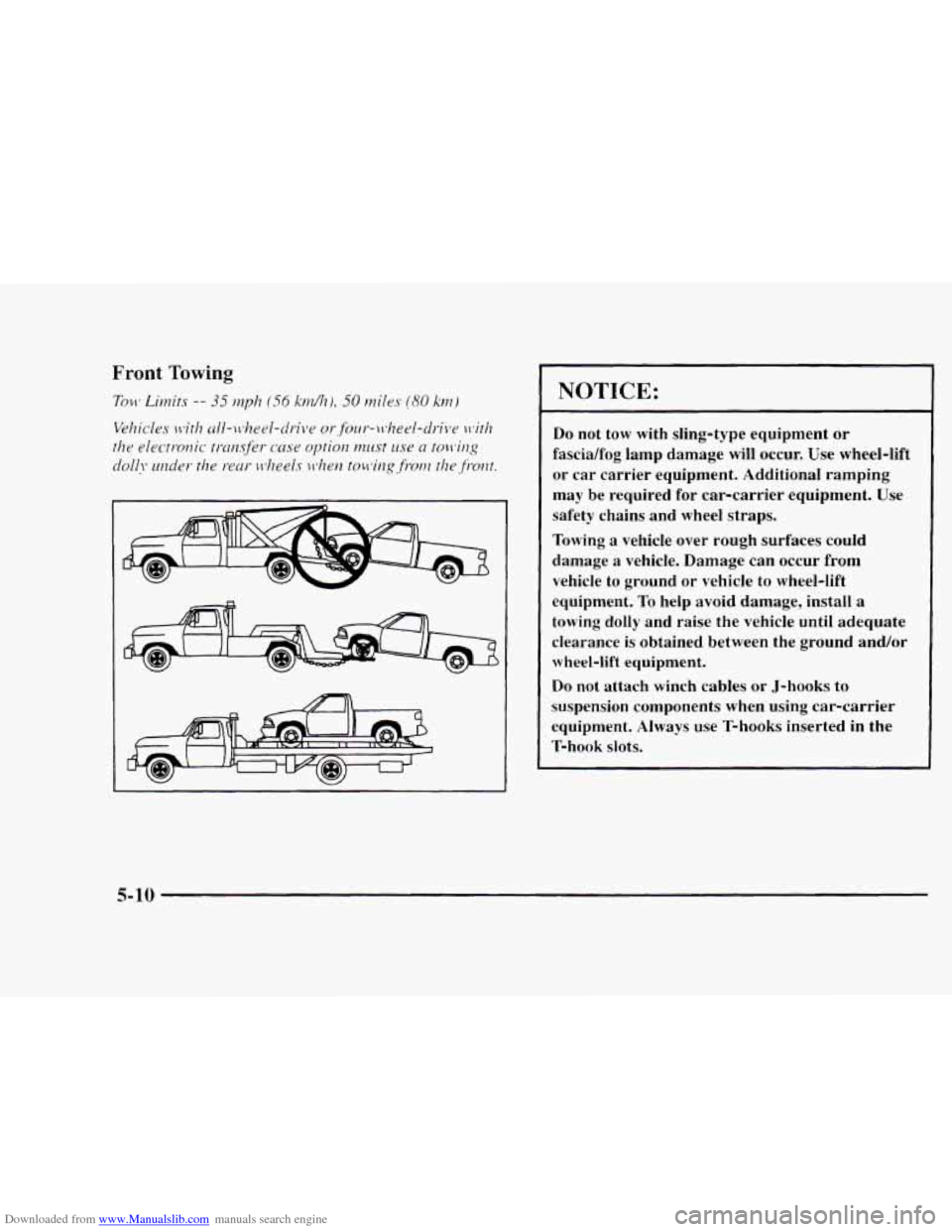
Downloaded from www.Manualslib.com manuals search engine NOTICE:
Do not tow with sling-type equipment or
fascia/fog lamp damage will occur. Use wheel-lift
or car carrier equipment. Additional ramping may be required for car-carrier equipment. Use
safety chains and wheel straps.
Towing
a vehicle over rough surfaces could
damage
a vehicle. Damage can occur from
vehicle to ground or vehicle to wheel-lift
equipment. To help
avoid damage, install a
towing dolly and raise the vehicle until adequate
clearance
is obtained between the ground and/or
wheel-lift equipment.
Do not attach winch cables or J-hooks to
suspension components when using car-carrier
equipment. Always use T-hooks inserted in the
T-hook slots.
5-10
Page 228 of 402
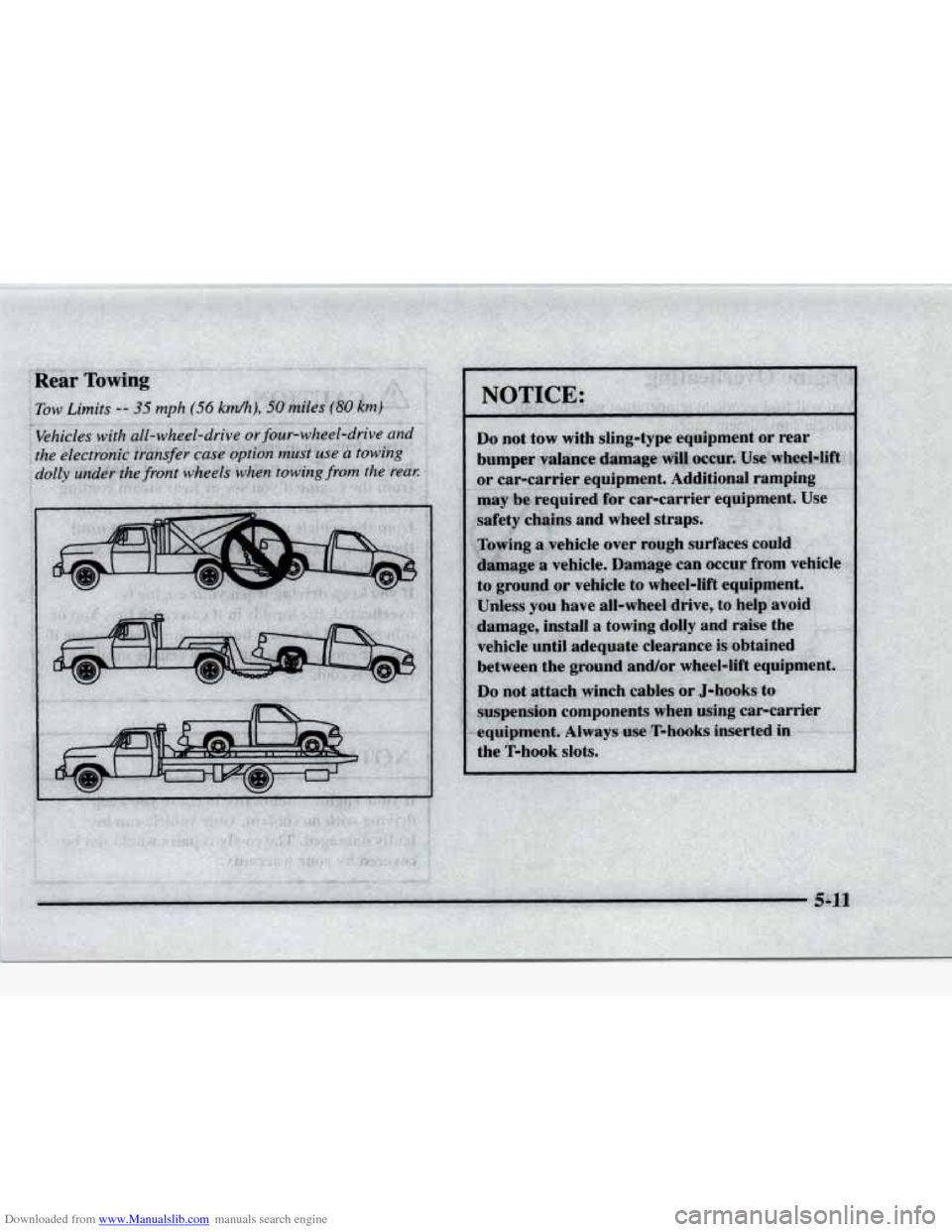
Downloaded from www.Manualslib.com manuals search engine Tow Limits -- 35 mph (56 kd), 30 miles@3O krn)
'*Vehicles with all- wheel-drive or four-wheel-drive and
the electrbni'c transfer case DptibMmlasritse'a iowing
dully undwthefront wheels &hen towing from the reay:
~, ..
Do not tow with sling-type equipment or rea
bumper valance damage will occur. Use whee
or car-carrier equipment. Additional ramping
may be required for car-carrier equipment.
safety chains and wheel straps.
Towing
a vehicle over rough surfaces could
damage
a vehicle. Damage can occur from vehicle
to ground or vehicle to wheel-lift equipment.
Unless you have all-wheel drive,
to help avoid
damage, install
a towing dolly and raise the
vehicle until adequate clearance
is obtained
between the ground and/or wheel-lift equi
Do not attach winch cables or J-hooks to
suspension components when
using car-carrier
equipment. Aiways use T-hooks inserted in
. ' .I ., . +y2zL. .r I> -
Page 326 of 402

Downloaded from www.Manualslib.com manuals search engine Short TripKity Maintenance Schedule
The services shown in this schedule up to 100,000 miles
( 166 000 km) should be performed after 100,000 miles
(166 000 km) at the same intervals. The services shown
at
150,000 miles (240 000 km) should be performed at
the same interval after 150,000 miles
(240 000 km).
See “Owner Checks and Services” and “Periodic
Maintenance inspections” following.
Footnotes
? The U.S. Environmental Protection Agency or the
California Air Resources Board has determined that
the
failure to perform this maintenance item will not nullify
the emission warranty or limit recall liability prior
to the
completion of the vehicle’s
useful life. We, however,
urge that all recommended maintenance services
be
performed at the indicated intervals and the maintenance
be recorded.
# Lubricate the front suspension, ball joints, steering
linkage and transfer case shift linkage, parking brake
cable guides, propshaft splines, universal joints and
brake pedal springs.
+ A good time to check your brakes is during tire
rotation. See “Brake System Inspection” under “Periodic Maintenance Inspection” in Part
C of this schedule.
** Drive axle service (see “Recommended Fluids and
Lubricants’’ in
the Index for proper lubricant to use):
0
a
0
Locking Differential -- Drain fluid and refill at first
engine oil change. At subsequent oil changes, check
fluid level and add fluid as needed. If driving in
dusty areas or towing a trailer, drain fluid and refill
every
15,000 miles (25 000 km).
Standard Differential -- Check fluid level and add
fluid
as needed at every oil change. If driving in
dusty areas
or towing a trailer, drain fluid and refill
every
15,000 miles (25 000 km).
More frequent lubrication may be required for
heavy-duty
or off-road use.
Page 349 of 402

Downloaded from www.Manualslib.com manuals search engine The services shown in this schedule up to 100.000 miles
( 166 000 km) should be performed after 100,000 miles
( 166 000 km) at the same intervals. The services shown
at
150.OOO miles (240 000 km) should be performed at
the same interval after 150.0OO miles
(240 000 km ).
See "Owner Checks and Services" and "Periodic
Maintenance Inspections" following.
Footnotes
-f- The U.S. Environmental Protection Agency or the
California Air Resources Board has determined that the
failure to perform this maintenance item.
will not nullify
the emission warranty or limit recall liability prior to the
completion of the vehicle's useful life. We. however.
urge that all recommended maintenance services be
performed at the indicated intervals and the maintenance
be recorded.
# Lubricate the front suspension, ball joints, steering
linkage and transfer case shift linkage. parking brake
cable guides. propshaft splines. universal joints and
brake pedal springs.
+ A good time to check your brakes is during tire
rotation. See "Brake System Inspection" under "Periodic
Maintenance Inspections" in
Part C of this schedule.
** Drive axle service (see "Recommended Fluids and
Lubricants"
in the Index for proper lubricant to use):
Locking Differential -- Drain fluid and refill at first
engine oil change. At subsequent oil changes, check
fluid level and add fluid as needed.
Standard Differential -- Check fluid level and add
fluid as needed
at every engine oil change.
More frequent lubrication may be required for
heavy-duty or off-road use.
7-30
Page 369 of 402
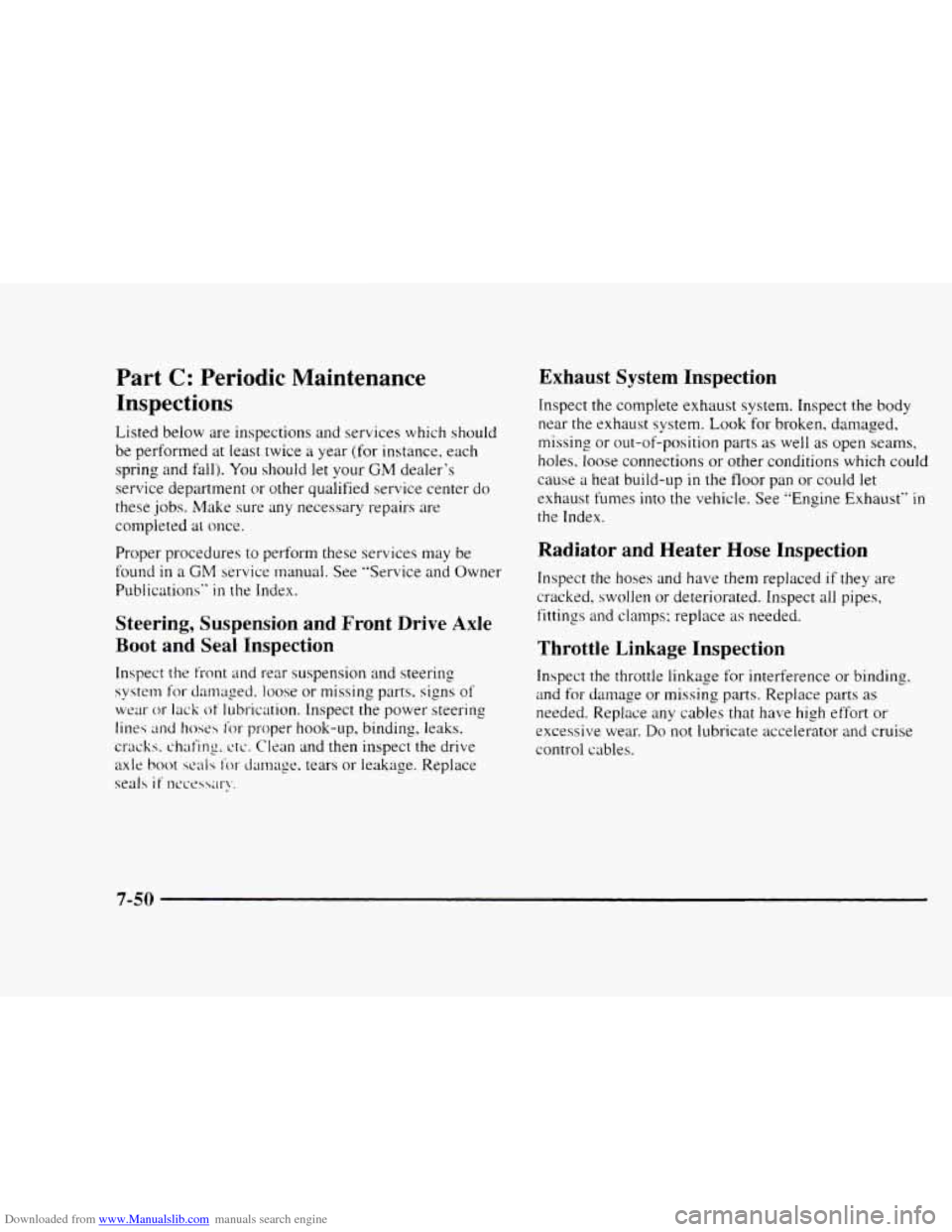
Downloaded from www.Manualslib.com manuals search engine Part C: Periodic Maintenance
Inspections
Listed below are inspections and services which should
be performed at least twice
a year (for instance. each
spring and
fall). You should let your GM dealer's
service department or other qualified service center do
these
jobs. Make sure any necessary repairs are
completed at
cme.
Proper procedures to perform these services may be
found
in a CM service manual. See "Service and Owner
Publications"
in the Index.
Steering, Suspension and Front Drive Axle
Boot and Seal Inspection
Inspect the front md rear suspension and steering
system for datna_ced. loose or missing parts. signs of
wear or lack of lubrication. Inspect the power steering
lines and hoses for proper hook-up, binding, leaks,
cracks.
chafing. ctc. Clean and then inspect the drive
axle
hoot seals for dm~age. tears or leakage. Replace
seal5
if nccessq'.
Exhaust System Inspection
Inspect the complete exhaust system. Inspect the body
near the exhaust system.
Look for broken, damaged.
missing or out-of-position parts
as well as open seams,
holes. loose connections or other conditions which could
cause a heat build-up in the floor pan or could let
exhaust
fumes into the vehicle. See "Engine Exhaust" in
the Index.
Radiator and Heater Hose Inspection
Inspect the hoses and have them replaced if they are
cracked, swollen or deteriorated. Inspect
all pipes,
fittings and clamps; replace
as needed.
Throttle Linkage Inspection
Inspect the throttle linkaze for interference or binding.
and for damage or missing parts. Replace parts
as
needed. Replace any cables that have high effort or
excessive wear.
Do not lubricate accelerator and cruise
control
cables.